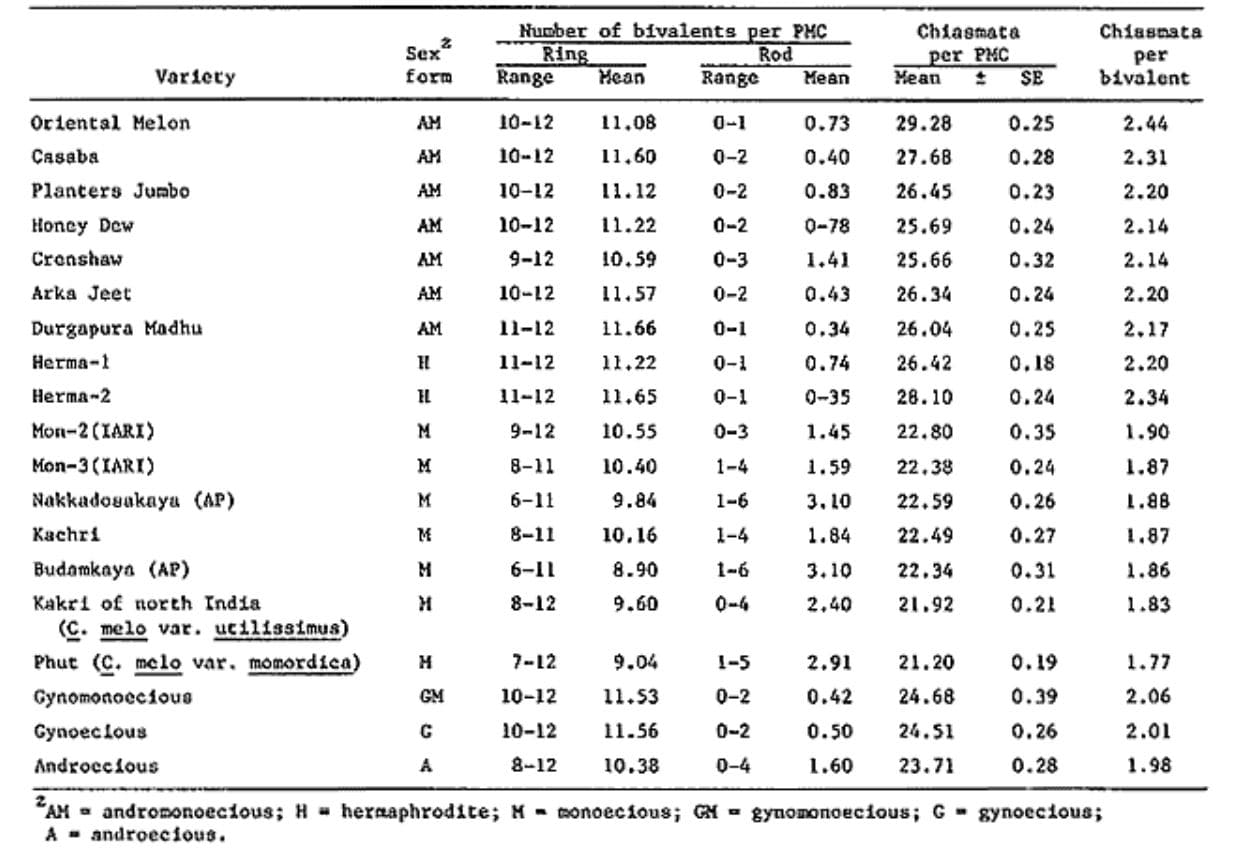Cucurbit Genetics Cooperative Report 6:54-56 (article 28) 1983
C. Ramachandran, V. S. Seshadri and R. A. Pai
Divisions of Vegetable and Floriculture and Genetics, Indian Agricultural Research Institute, New Delhi-110 012- India
The pairing behavior of chromosomes at meiosis is closely associated with recombination. Chiasma frequency is a cytological measure of such recombinations. The relationship of breeding system with chiasma frequency and recombination in crop plants has been dealt by many workers (1, 4). There are no reports of the comparative chiasma frequencies of the different sex forms of muskmelon. Trevedi and Roy reported the chiasma frequency in an andromonoecious variety (5). We compared chiasma frequency of 6 sex forms of muskmelon: andromonoecious, monoecious and hermaphrodite which are phenotypically stable, and gynomonoecious, gynoecious and androecious which are phenotypically unstable. The latter three forms were obtained only in segregating populations.
The cytological technique comprised of fixation of male or hermaphrodite flower buds for 24 hours in acetoalcohol (1:3) mixed with 2–3 drops ferric acetate. These were then squashed in 1% acetocarmine. Bisexual flowers were induced on the gynoecious entries by treating with 500 ppm silver nitrate. The mean number and type of bivalent, mean number of chiasmata per PMC and chiasmata per bivalent were calculated from observation of 100 PMC per variety (Table 1).
The hermaphrodite and andromonoecious varieties had comparable chiasma frequency which was higher than the monoecious varieties (Table 1). The unstable gynomonoecious, gynoecious and androecious varieties were intermediate in chiasmata frequency and were comparable to each other. The high frequency of ring bivalents is attributed to increased chiasma frequency.
The extent of self pollination is comparatively high in andromonoecious and hermaphrodite varieties even though they are naturally cross pollinated by insects. In monoecious varieties the self pollination varies 0–10% (6). Chiasma frequency varies considerably within the same plant. In those forms with a high frequency of self pollination, variability within the gene pool is ensured by higher chiasma frequency. This phenomenon has been discussed by Stebbins (4), Rees (3), Grant (1), and Jones and Rees (2). It is also interesting to note that chiasma frequency is high (25–29) in the andromonoecious varieties which are highly domesticated compared to the monoecious varieties (21–22) which are semi-wild non-dessert types.

Table 1. Chiasma frequency in sex forms of muskmelon.
Literature Cited
- Grant, V. 1958. The regulation of recombination in plants. Cold Spring Harb. Symp. Quant. Biol. 23:337–363.
- Jones, N. and H. Rees. 1966. Chiasma frequencies and the potential genetic variability of Lolium populations. Nature 211:432–433.
- Rees, H. 1961. Genotypic control of chromosome form and behavior. Bot. Rev. 27:288–319.
- Stebbins, G. L. 1958. Longevity, habitat and release of variability in the higher plants. Cold Spring Harb. Symp. Quant. Biol. 23:365–378.
- Trivedi, R. N. and R. P. Roy. 1970. Cytological studies in Cucumis and Citrullus. Cytologia 35:561–569.
- Whitaker, T. W. and G. W. Bohn. 1952. Natural cross pollination in muskmelon. Proc. Amer. Proc. Hort. Sci. 60:391–396.